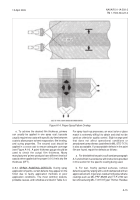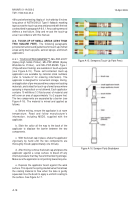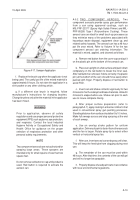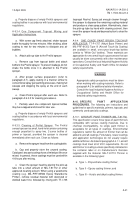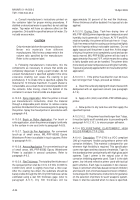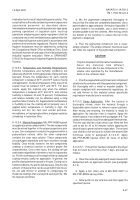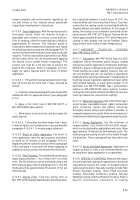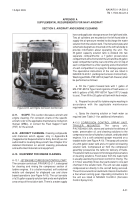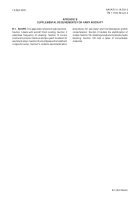TM-1-1500-344-23-2 - Page 194 of 240
A-24
NAVAIR 01-1A-509-2
TM 1-1500-344-23-2
15 April 2009
a. Consult manufacturer’s instructions printed on
the container label for proper mixing procedures. If
distilled or deionized water is specified, do not add tap
water. Tap water will have an adverse affect on film
properties. Only add the specified amount of water. Do
not add excess water.
CAUTION
Only mix materials from the same manufacturer.
Never mix materials from different
manufacturers. Mix the two components in the
volume ratio specified by the manufacturer.
Refer to the container label.
b. Following manufacturer’s instructions, mix the
components as necessary to ensure that solids are
completely dispersed. If using a paint shaker, do not
exceed manufacturer’s specified agitation time since
excessive shaking can cause the coating to gel
prematurely. If no shake time is specified, agitate the
material for 10 minutes maximum. If a paint shaker is
not available, use a clean metal or wooden paddle to stir
the contents. After mixing, check the bottom of the
container to ensure that all solids are dispersed.
A-10.3.5. Spray Application. After the primer is mixed
per manufacturer’s instructions, strain the material
through a disposable paint strainer to remove coarse
particles. No induction time is necessary prior to spraying
this primer. Spray the mixed primer in accordance with
paragraph A-8.
A-10.3.6. Brush or Roller Application. For brush or
roller application, strain the primer and apply it uniformly
to the surface in one coat (refer to paragraph A-8.5).
A-10.3.7. Touch-Up Pen Application. For convenient
touch-up of small areas, MIL-PRF-85582 Epoxy
Waterborne Primer is available in touch-up pens. Refer
to paragraph A-9.1.
A-10.3.8. Aerosol Application. For convenient touch-up
of small areas, MIL-PRF-85582 Epoxy Waterborne
Primer is available in aerosol containers. Refer to
paragraph A-9.3.
A-10.3.9. Film Thickness. The total dry film thickness of
the sprayed primer shall be 0.6 to 0.9 mils (0.0006 to
0.0009 inch) which is slightly more than a mist coat.
After the coating has dried, the substrate should be
barely visible through the film. Dry film thickness can be
estimated using a wet film thickness gage (refer to
paragraph A-5.7). Dry film thickness will be
approximately 50 percent of the wet film thickness.
Primer thickness shall be doubled if no topcoat is to be
applied.
A-10.3.10. Drying Time. Tack-free drying time of
MIL-PRF-85582 primer depends upon temperature and
humidity, but is generally 1 to 2 hours. At 70
°
F and 50%
relative humidity, the primer will be tack-free in 1 hour.
Tack-free means that the coating can be touched lightly
with the fingertip without noticeable tackiness. Do not
apply topcoat until the primer is tack-free. At this stage
of drying, the primer is not completely cured and can be
easily marred. MIL-PRF-85582 primer will dry hard in
approximately 6 hours at 70
°
F, which means the coating
is fairly durable and can be handled. The primer dries
more slowly at lower temperatures and higher humidity.
Topcoat is generally applied within 24 hours after primer
application.
A-10.3.10.1. If the primer has dried for over 24 hours
but not longer than 7 days, proceed as follows:
a. Clean the surface by wiping with clean cheesecloth
dampened with an approved solvent (see paragraph
A-7.4).
b. Apply a thin (mist) coat of MIL-PRF-85582 epoxy
primer.
c. Allow primer to dry tack-free and then apply the
specified topcoat.
A-10.3.10.2. If the primer has dried longer than 7 days,
it must be lightly scuff sanded prior to proceeding with
paragraph A-10.3.10.1, to ensure proper adhesion.
A-10.4. POLYURETHANE, ELASTOMERIC, HIGH
SOLIDS PRIMER (TT-P-2760).
A-10.4.1. Description. TT-P-2760 is a VOC compliant
(340 g/l maximum) flexible polyurethane primer with
corrosion inhibitors. This material is designed for use
wherever high flexibility is required. This specification
covers two types and two classes of materials. Type I is
the standard primer used primarily with high gloss paint
systems. Type I primer is the natural color of the
corrosion inhibiting pigments used. Type II is the dark
green, low infrared reflective primer used with tactical
paint schemes. Each type is available in two classes:
Class C (strontium chromate based corrosion inhibitor)
and Class N (non-chromate based corrosion inhibitor).
Consult specific maintenance instructions for guidance
on the selection of primers for each weapons system.
Class C shall be selected when no class is specified.
Back to Top


